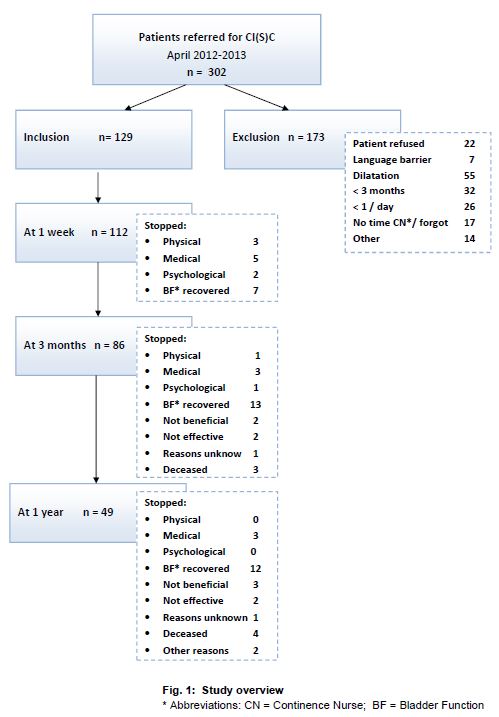Dutch studies on self-catheterisation offer insights on patient experience

Co-authors of the project: Edith van Wijlick, Joke Beekman
In 2012 we presented a study project at the EAUN congress titled ‘Which factors make clean intermittent (self) catheterisation successful?’ which won us the research grant for the Best Nursing Research Project!
For the quantitative study, a prospective multicentre study was conducted in a university hospital, a general hospital and a rehabilitation centre in Nijmegen, The Netherlands, from March 2012 to March 2013 with a one year follow-up. Patients with a variety of diagnoses referred to the outpatient clinic, who were ≥18 years, performed catheterisation at least once a day for three months or longer were included. During the study period, 302 patients were referred for intermittent catheterisation. Of these, 129 were included.
 Of the 129 (72 male) patients, mean age 62 (22–86) years, seven died and 63 stopped, 32/63 (50%) due to recovered bladder function. Fifty-nine (47%) continued to perform catheterisation after one year. Forty-seven (86%) patients reported catheterisation had become part of their life or had a positive effect on their life.
Of the 129 (72 male) patients, mean age 62 (22–86) years, seven died and 63 stopped, 32/63 (50%) due to recovered bladder function. Fifty-nine (47%) continued to perform catheterisation after one year. Forty-seven (86%) patients reported catheterisation had become part of their life or had a positive effect on their life.
Related to the hypothesis that specific causes can influence the adherence negatively, we only found a weak correlation between increasing age and cessation of catheterisation. However, we feel this correlation is not strong enough and we think that the possibility of offering intermittent catheterisation as an option for older patients should be discussed.
The hypothesis that if catheterisation was beneficial for the patient, it would influence adherence to the regime positively was not confirmed. Surprisingly we found that of the patients that discontinued intermittent catheterisation in 50% of respondents, this was due to a recovery of bladder function, and as far as we know this has never been reported before.
Further prospective studies on the long-term adherence of intermittent catheterisation in larger groups are needed. Definition of intermittent catheterisation, patient’s education, catheter use, frequency and follow-up care must be better documented to compare results. The project group advised next to the quantitative study also to perform a qualitative study.
We then conducted an additional qualitative study using semi structured in-depth interviews about the experiences of 11 patients from the quantitative study. The aim of this study was to get insight in underlying barriers and facilitators for patients dealing with intermittent catheterisation in everyday life. Patients were asked about the initial use of intermittent catheterisation, its use in everyday life, the perceived progress after receiving instruction and guidance, the cause of the bladder problem and the
motivation to start intermittent catheterisation.
Eleven interviews were performed (six males/five females). All patients described the instruction and follow-up care as positive. Among the barriers were the preparation before the handling, which is more difficult than the catheterisation itself, and the fact that patients felt constrained by the need to plan convenient times to catheterise themselves. Both studies were recently published in the Journal of Clinical Nursing, and the publication details are as follows:
Hanny Cobussen-Boekhorst, Joke Beekman, Edith van Wijlick, Judith Schaafstra, Dirk van Kuppevelt and John Heesakkers. Which factors make clean intermittent (self) catheterisation successful? Journal of Clinical Nursing, 2016 doi: 0.1111/jocn.13187
Hanny Cobussen-Boekhorst, Erna Hermeling, John Heesakkers and Betsie van Gaal. Patients’ experience with intermittent catheterisation in everyday life. Journal of Clinical Nursing, 2016 doi: 10.1111/jocn.13146
To conclude, these study projects were a great experience, involved a lot of work but gave us the opportunity to work multicentre with very motivated continence nurses. Moreover, this was made possible by the EAUN!
Author: Hanny Cobussen-Boekhorst, dr. MANP, Radboudumc, Dept. of Urology, Nijmegen (NL), hanny.cobussenboekhorst@radboudumc.nl

